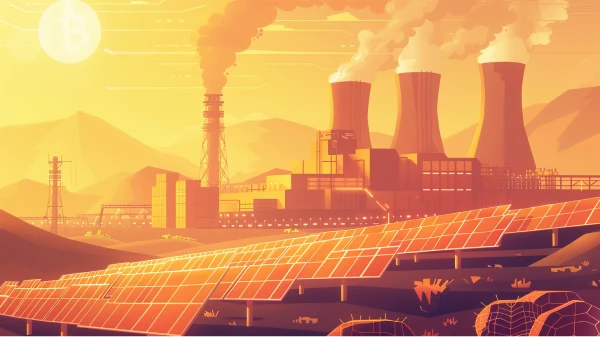How Does Bitcoin Consume Energy?
Bitcoin’s network consumes energy by transforming electricity into monetary value through the mining process. Buying, selling, holding and running a node consume negligible amounts of energy as compared to mining. Bitcoin’s Proof-of-Work algorithm requires compute power, time, and electricity to create new blocks and establish consensus.
Bitcoin Mining
Bitcoin miners consume energy to add blocks to the blockchain. Each new block rewards the miner who created it with bitcoin, called the block reward. The block reward contains a block subsidy plus transaction fees for discovering the new block. Accordingly, miners consume costly energy because the block reward presents a strong economic incentive to minimize energy costs.
ASIC Machines and Hash Rate
Bitcoin miners in recent history have turned predominantly to application-specific integrated circuit (ASIC) machines, which use energy to generate large random numbers called hashes. The ASIC will then check the validity of each hash. Only one hash will successfully unlock the next block and connect it to the blockchain.
Proof-of-Work
The process of hashing is energy intensive but allows the network to operate without a trusted central authority. A valid hash serves as proof that the miner has spent time and energy working to secure the blockchain.
Block Reward Economic Incentive
The block reward has value to miners because of the block subsidy and transaction fees. The block subsidy is the amount of new bitcoin released in each block, which halves every 210,000 blocks. The current block subsidy is 6.25 BTC per block mined. Miners are also rewarded with transaction fees, which typically range between 5-10% of the total block reward.
How Much Energy Does Bitcoin Consume?
The amount of energy consumed by the Bitcoin network is determined by the hash rate, the price of bitcoin, and the cost of electricity. The price of bitcoin influences the amount of energy miners consume, because rational miners will not spend more in electricity costs to mine a block than the value of the block reward. Bitcoin will consume as much energy as miners are willing to expend for the block reward.
➤ Learn more about how the Cambridge Bitcoin Electricity Consumption Index tracks Bitcoin energy statistics.
Network Hash Rate
Bitcoin’s total network hash rate will determine the amount of energy the network consumes. Lower network hash rate will result in less energy consumption. Higher hash rate will increase the amount of energy used by the network to mine each new block. Accordingly, the network hash rate directly impacts the amount of energy consumed by the network.
Bitcoin’s Energy Consumption vs. Traditional Monetary Systems
Although Bitcoin’s Proof-of-Work energy consumption receives increasing media scrutiny as the network continues to grow, it remains the most direct transformation of energy into money. Today, central banks around the world may print new fiat money by expending very little energy, which makes it easier to debase the currency. Accordingly, Bitcoin’s Proof-of-Work offers higher security and immutability in exchange for energy consumption. In addition, Bitcoin’s energy intensive consensus mechanism is a tradeoff for the guarantee that no government can increase its supply. Proof-of-Work allows Bitcoin to avoid reliance on trusted centralized authorities, making its monetary policy more trustworthy and predictable than any Central Bank.
What Kind of Energy Does Bitcoin Consume?
Bitcoin miners navigate to low cost and predictable energy sources. Some of those energy sources emit more CO2 than others, but the majority of the network mining capacity is powered with renewable energy.
Renewable Energy
A successful mining operation requires analysis of factors such as geographic location, grid capacity and operations, as well as renewable energy availability. Increasingly, more miners are using renewable energy, as those forms of electricity are becoming more competitive with the price of fossil fuels.
Although the percentage of bitcoin mined with renewable energy is debated, wind farms in Texas, geothermal power plants in Iceland, and hydro-powered dams in Canada have received attention as promising new locations for miners following China’s ban on ASIC mining. Similarly, El Salvador plans to power a large portion of its mining operations with geothermal energy from the country’s volcanos.
Wasted Non-Renewable Energy
Wasted non-renewable energy is also used to mine bitcoin. Most oil and natural gas operations produce excess gas as a byproduct of fracking or other oil production methods. This energy is typically wasted because it dissipates into the atmosphere or is combusted. By capturing and using gas that would otherwise be flared, bitcoin mining operations greatly reduce waste and methane emissions from fracking operations. Bitcoin miners are able to utilize wasted energy and have a cost incentive to find and collect forms of wasted energy.
How Will Bitcoin’s Energy Consumption Change Over Time?
In 2021, China’s bitcoin mining ban caused the network hash rate to drop by more than 25%, prompting miners to relocate their businesses elsewhere. Estimates report that China accounted for at least 65% of bitcoin mining activities in 2020, followed by the U.S. and Russia, with less than 10% each. This ban is good for the Bitcoin network becasue it disperses China’s concentrated mining pools to new locations across the world.
Innovations in mining equipment will eventually render older and less energy efficient mining equipment obsolete. 2021 estimates compared Bitcoin’s total energy consumption to small European countries such as Sweden. However, the network’s total energy consumption has declined 50% from a recent peak in 2021 as miners seek more efficient and clean sources of electricity.
This decline in hash rate will reduce the amount of energy consumed by miners across the network, as they find alternative energy sources in different geographic regions of the world. Miners will continue to seek low-cost energy and, when possible, will create innovative solutions that capture energy that is currently being wasted. Miners in the network are unlikely to expend more in energy costs than the block reward would return. Eventually the network is predicted to hit a critical mass of energy consumption and plateau.
Key Takeaways
- Bitcoin miners consume energy to create new blocks and release new bitcoin.
- Bitcoin's proof-of-work algorithm converts energy into monetary value.
- The majority of bitcoin is mined with renewable energy.
- Otherwise wasted energy can be converted into Bitcoin mining capacity.


